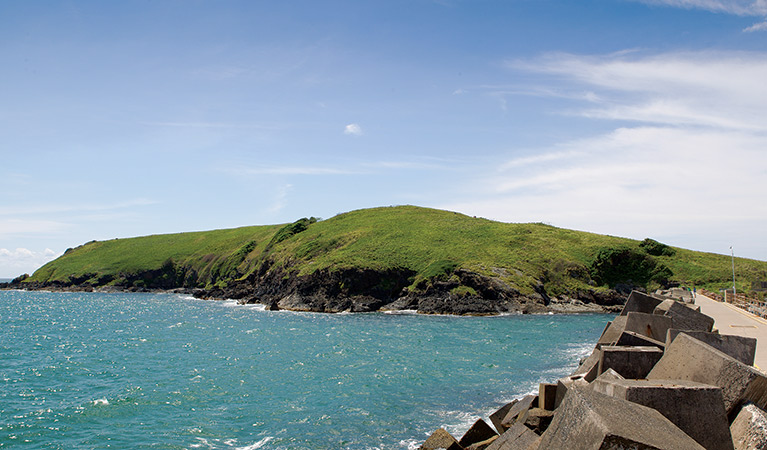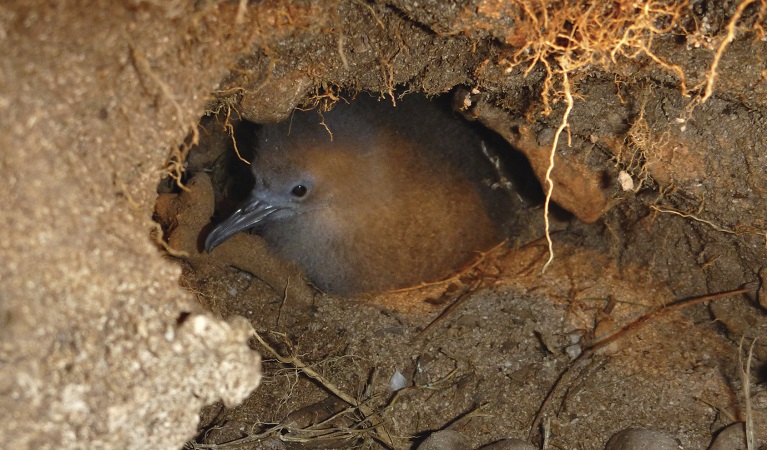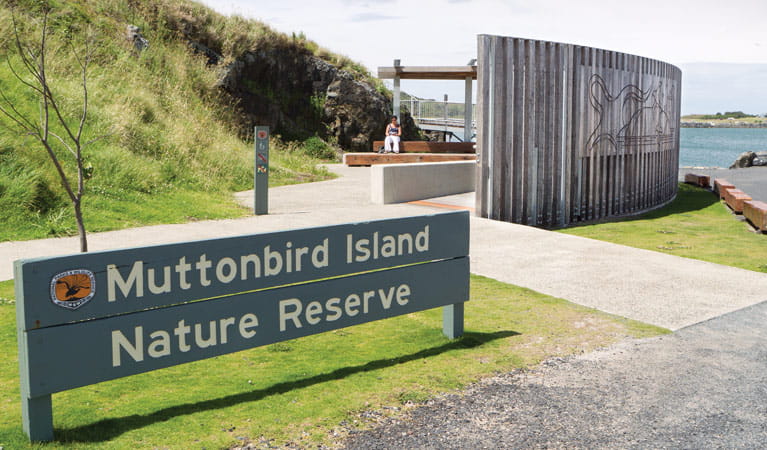Muttonbird Island Outdoor learning space
Muttonbird Island Nature Reserve
Open, check current alerts
Overview
Explore Aboriginal history and Dreamtime stories at Giidany Miirlarl, also known as Muttonbird Island, near Coffs Harbour.
- Type
- Education centres
- Accessibility
- Easy
- What to
bring - Hat, sunscreen, drinking water, sturdy shoes
- Bookings
- Tours are available on request. Fees apply. Phone (02) 6652 0927 or email the park office
- Please note
- Please refrain from disturbing the birds. This means no flash photography and always keep to the track
- Remember to take your binoculars if you want to bird watch or whale watch
Long before the island was connected to the shore, certain Gumbaynggirr people were the only ones permitted to venture here. They came to collect muttonbirds for food, protected for their survival by a giant moon-man guardian.
This fascinating Dreaming story and many others are explained in detail at the award-winning Muttonbird Island outdoor learning space. The display is located at the base of the western side of the island. Book a tour of the island to hear more about its flora, fauna, and the Dreaming stories of the Aboriginal People.
Pause to take in the past before embarking on the short island walk. Signage along the way explains the wedge-tailed shearwater’s itinerant lifestyle, the north coast’s geographic features and the marine life that lives in surrounding waters.
Also see
-

Eastern Side lookout
The Eastern Side lookout offers spectacular views of the Solitary Islands. A short walk from the carpark, it’s a great place for whale watching in the heart of Coffs Harbour.
Map

Map legend

Local alerts
For the latest updates on fires, closures and other alerts in this area, see https://www.nationalparks.nsw.gov.au/things-to-do/education-centres/muttonbird-island-outdoor-learning-space/local-alerts
Park info
- in Muttonbird Island Nature Reserve in the North Coast region
Muttonbird Island Nature Reserve is always open but may have to close at times due to poor weather or fire danger.
Visitor info
All the practical information you need to know about Muttonbird Island Outdoor learning space.
Getting there and parking
Muttonbird Island outdoor learning space is located at the base of the western side of the island.
Parking
Parking is available in and around the marina and waterfront precinct off Marina Drive, a short walk from Muttonbird Discovery display.
Accessible parking is available:
- There are 2 accessible parking spaces in front of the Fishermans Co-Op, mid-way along breakwall. From these parking spaces, there's a ramp that leads up to the breakwall.
- There are also accessible parking spaces in the carpark at Northwall, on the western end of the breakwall.
Best times to visit
There are lots of great things waiting for you in Muttonbird Island Nature Reserve. Here are some of the highlights.
Autumn
Take the ‘Muttonbirds by Moonlight' guided tour to find out more about the muttonbird parents' and fledglings' migratory journey to southeast Asia.
Spring
Head to the island's peak or eastern side to look for migrating whales – make sure to take your binoculars Muttonbirds will be breeding and nesting at this time of year, so look closely for them and be very careful not to disturb them .
Summer
Look for dolphins in the water and sea turtles around the marina area.
Winter
Guided tours to the South Solitary Island include a return helicopter flight and guided inspection of the lighthouse keepers' buildings and surrounds. They are only available for two weekends every year so you'll need to book ahead – check out the Precision Helicopters website to find out more about scenic flights and tours. During the school holidays take a free whale watching guided tour on the island .
Weather, temperature and rainfall
Summer temperature
Average
20°C and 27°C
Highest recorded
43.3°C
Winter temperature
Average
10°C and 20°C
Lowest recorded
-3.2°C
Rainfall
Wettest month
March
Driest month
September
The area’s highest recorded rainfall in one day
404.6mm
Facilities
Step-free access
There are step-free concrete pathways that go from the carpark and across the breakwall to the learning space. At the learning space, there's a timber boardwalk that leads through the area.
- Step-free outdoor pathways
Seats and resting points
There are timber bench seats at the learning space.
Maps and downloads
Accessibility
Disability access level - easy
Muttonbird Island Outdoor learning space is flat and step-free, with the following accessible features:
- Accessible parking spaces in the carparks mid-way along the breakwall and on the western end of the breakwall
- Flat, concrete pathways that lead across the breakwall to the learning space
- Timber bench seats for resting at the learning space
Prohibited
Drones
Flying a drone for recreational purposes is prohibited in this area. Drones may affect public enjoyment, safety and privacy, interfere with park operations, or pose a threat to wildlife. See the Drones in Parks policy.
This area may be a declared Drone Exclusion Zone, or may be subject to Civil Aviation Safety Authority (CASA) rules for flying near airports, aerodromes and helicopter landing sites. See CASA's Drone Flyer Rules.
Commercial filming and photography
Commercial filming or photography is prohibited without prior consent. You must apply for permission and contact the local office.
Pets
Pets and domestic animals (other than certified assistance animals) are not permitted. Find out which regional parks allow dog walking and see the pets in parks policy for more information.
Smoking
NSW national parks are no smoking areas.
Learn more
Muttonbird Island Outdoor learning space is in Muttonbird Island Nature Reserve. Here are just some of the reasons why this park is special:
Divers delight

Muttonbird Island marks the southern boundary of the Solitary Islands Marine Park. The marine park protects coral reefs, mangroves, sea-grass beds, rockpools and river estuaries. It's a diver's paradise, a place where fish species from the tropical north and temperate south mingle among the reefs.
- Eastern Side lookout The Eastern Side lookout offers spectacular views of the Solitary Islands. A short walk from the carpark, it’s a great place for whale watching in the heart of Coffs Harbour.
- Muttonbirds by moonlight guided tour Join us on a short, guided evening tour for a chance to see the birds that give Muttonbird Island its name. We'll walk the breakwall path together from Coffs Harbour to Muttonbird Island.
Giidany Miirlarl

Muttonbird Island is a sacred and significant site to the local Gumbaynggirr Aboriginal people, who call the island Giidany Miirlarl, meaning moon sacred place. The moon is the island's protector, guarding the muttonbirds as a food source and protecting them from over-harvesting. The island was also a ceremonial site. Find out more about the cultural significance of Gumbaynggirr Country, taste bush tucker foods and learn about traditional uses of plants for medicine and shelter on a guided tour with one of the Aboriginal Discovery Rangers.
Love nest

The island is home to thousands of wedge-tailed shearwaters, so called for their ability to cut or shear the water with their wings as they skim across the surface. Early settlers called them muttonbirds because of their fatty mutton-like flesh. The birds spend the Australian winter in southeast Asia, travelling back to Muttonbird Island in August each year. Amazingly, the birds return to the same burrow every year. A pair of birds share the responsibility of keeping one single egg warm and then share the raising of their chick. During the day they forage for food and return to their burrow just after dusk. They depart on their annual migration in late April every year.
- An island sanctuary self-guided audio tour Go on a self-guided audio tour with Matt Flanders across Muttonbird Island and discover the significance of this bustling seabird rookery. Take in the spectacular views as you stroll towards the eastern lookout and learn about the shearwaters that nest here.
- Eastern Side lookout The Eastern Side lookout offers spectacular views of the Solitary Islands. A short walk from the carpark, it’s a great place for whale watching in the heart of Coffs Harbour.
- Muttonbirds by moonlight Muttonbirds by Moonlight is an Ecosystems at risk school excursion on Muttonbird Island, a nesting rookery for wedgetail shearwaters, for Stage 6 (Years 11-12) students focusing on Geography.
- Muttonbirds by moonlight Join us at twilight for a fascinating exploration of Muttonbird Island and its nesting rookery for thousands of wedge-tailed shearwaters. This Stage 2 (Years 3-4) Geography excursion examines the features and characteristics of this unique place and environment.
- Muttonbirds by moonlight guided tour Join us on a short, guided evening tour for a chance to see the birds that give Muttonbird Island its name. We'll walk the breakwall path together from Coffs Harbour to Muttonbird Island.
Plants and animals protected in this park
Animals
-

Australian pelican (Pelecanus conspicillatus)
The curious pelican is Australia’s largest flying bird and has the longest bill of any bird in the world. These Australian birds are found throughout Australian waterways and the pelican uses its throat pouch to trawl for fish. Pelicans breed all year round, congregating in large colonies on secluded beaches and islands.
School excursions (5)
- Giidany Miirlarl: A special site, Stage 3 (Years 5-6), Science and Technology
- Muttonbirds by moonlight, Stage 6 (Years 11-12), Geography
- The rookery roundabout at Muttonbird Island, Stage 1 (Years 1-2), Science and Technology
- Giidany Miirlarl: A special site, Stage 2 (Years 3-4), Geography
- Muttonbirds by moonlight, Stage 2 (Years 3-4), Geography

